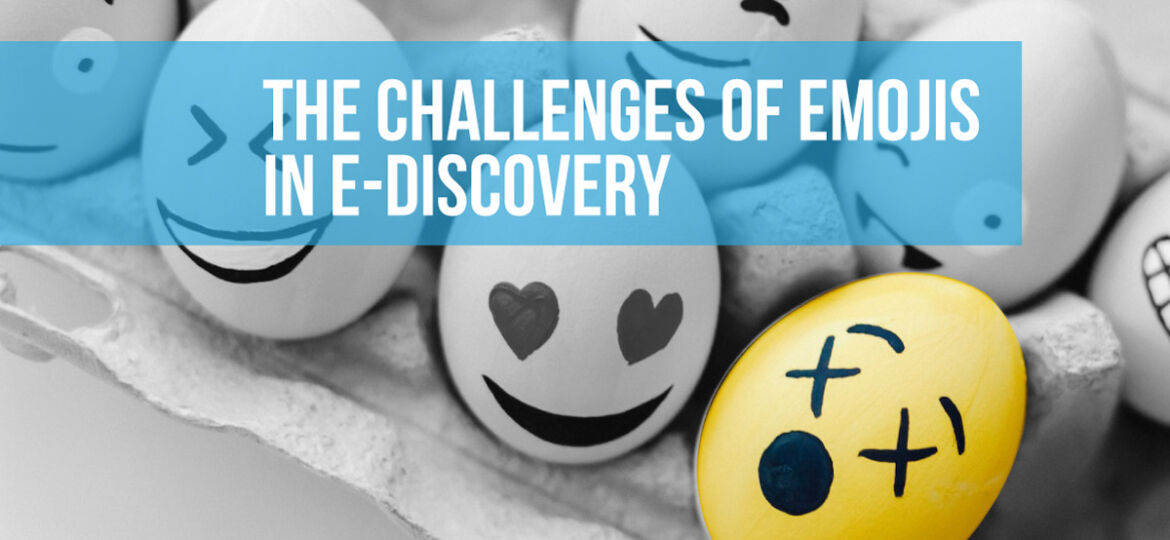
This six-minute article focuses on the technical challenges that EMOJIs present to digital forensics and e-discovery professionals.
With the proliferation of instant messaging technology, written communication has become far less formal than it was just ten years ago. Telephone conversations, written letters, and even emails have become passe, too time-consuming, and too slow for our modern society.
Today, instant messaging reigns supreme, even in business. There has been a pronounced decline in the use of formal written communications in favor of short-form text messaging via chat applications and collaboration software.
With this shift to text messaging, emojis have gained popularity because they fill a need to provide context for messages that would otherwise be open to interpretation. Emojis offer a convenient shortcut to express emotion, indicate sarcasm, or communicate complex ideas quickly.
This article is not going to highlight the numerous court cases involving emojis over the past few years. Many articles have already been written that review case law and discuss the challenges of correctly interpreting the meaning of emojis. Instead, this article will highlight the technical difficulties that e-discovery professionals face when they collect, analyze, and produce ESI that contains emojis.
The History of Emojis
In the history of human communication, emojis have been a relatively new development. The first widespread deployment of emojis occurred in 1999 when a Japanese mobile phone company included a set of 176 pictograms for use with text messaging. The popularity of these pictograms snowballed, spreading to many other platforms over the next decade.
How do Emojis Work?
Technically, emojis aren’t that different from the characters we find on our keyboard. For years, computers were limited to minimal character sets. The previously popular ASCII character encoding standard worked well for decades but was limited to 256 possible characters.
Promising to provide a universal coding standard for all modern and classical languages, the Unicode Consortium released the Unicode character-encoding standard in 1991. Unicode made universal emojis compatibility possible, providing emojis a permanent home among characters from all the world’s languages.
While there is agreement on the encoding of emoji character sets, it’s puzzling that there is no universal set of emoji images—that’s left to each operating system to provide its own emojis. In general, these sets are harmonized and similar in appearance. However, sometimes there is a vast difference between these icons.
Here is another complication—different operating systems have different emoji libraries, as do major communication platforms like Gmail, Microsoft Teams, WhatsApp, Facebook, and others.
That’s a problem. When you send an emoji from one platform, it’s entirely likely that the recipient will see a slightly different emoji if they are not viewing the message on the same platform.
For instance, if I send a message from my Apple iPhone 13 to my buddy with an LG Velvet phone, they could potentially see a very different emoji. (See below)
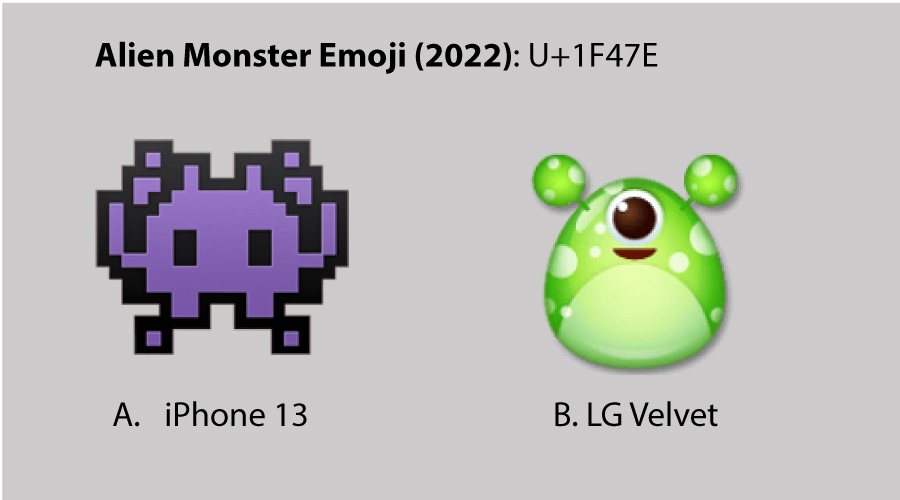
The challenge to E-Discovery Professionals
As digital forensics and e-discovery professionals, the ESI we collect, analyze, and produce must be 100% accurate. The problem with emojis is that the graphical representation of emoji characters shifts through the course of communication and then again during the different phases of e-discovery.
What the sender sent might be different than what the recipient saw. The forensic examiner might see the emoji differently. The document reviewer may see yet another version. The production of the ESI with emojis again might show a completely different graphic. Where is the truth?
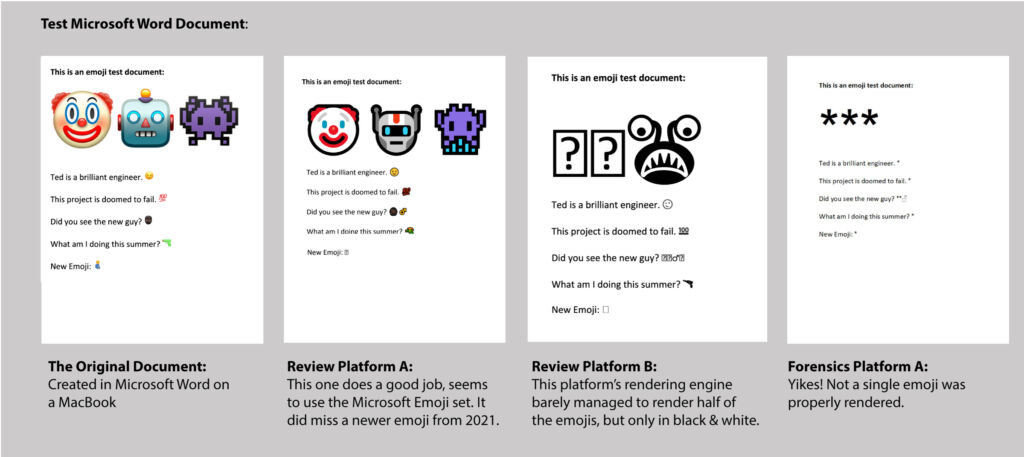
The Complications of Time
Yet, there are additional complications. Platforms can change the graphical design of their emoji sets at any time. Famously, Apple changed the design of the gun emoji from a revolver to a squirt gun in 2018.
Let’s say you are reviewing documents in an e-discovery matter that spans from 2017 to 2022. Depending on when the emoji was sent, a gun could have appeared as a threatening revolver or a harmless squirt gun. Furthermore, the viewer today will only see the current version of the icon (a squirt gun) without understanding what was actually sent and received.
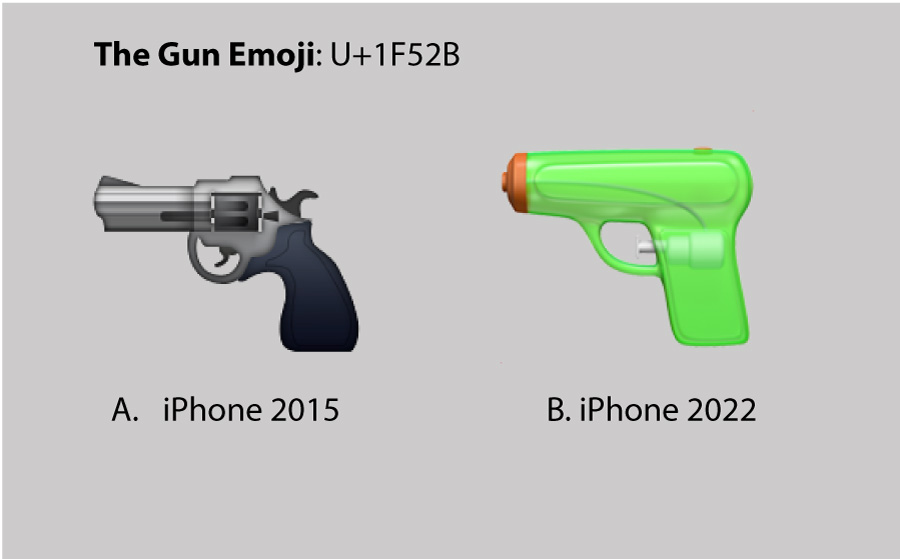
Review & Analytics Platforms
Another wrinkle is that your analytics and review platforms will have their own way of displaying emojis. These platforms have built-in rendering engines that simulate the views of popular file types. We tested four review platforms and found that two of them rendered the emojis in primitive black and white.
Still, three of them had problems with rendering the emojis in a manner that was reasonably consistent with the original document. All of them failed to correctly display series 15.0 emojis that were introduced in 2021.
And what about Skin Tone?
Skin tone variations of emojis were introduced in 2019 to help represent a more diverse world. These emojis are encoded as multi-part Unicode characters that pair a base emoji (e.g., a man) with a skin tone (e.g., dark skin).
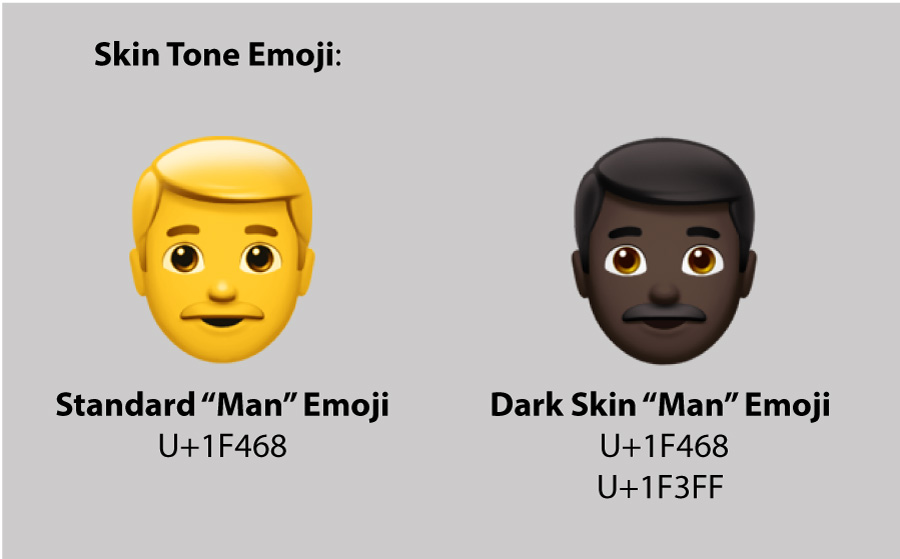
You can forget about discerning skin tone if your emojis are rendered in black and white. Even if the platforms did render emojis correctly, they often generated additional nonsense characters, seemingly confused by the multi-part Unicode required by skin tone emojis.
Good Luck Searching for Emojis
While using a review platform to search for text is straightforward, it’s an entirely different matter to search for emojis. We tested four popular review platforms, but only one could accept an emoji into the search field and subsequently search for it. This is a problem.
Let’s suppose that I’m investigating a sexual harassment lawsuit at my company, and I find out a particular employee has been sending lewd texts to co-workers that contain suggestive emojis. It would be helpful if I could initiate a search for specific emoji (let’s say a peach emoji) across all messages and emails sent by the employee. Most review platforms cannot currently do this.
What’s Your Final Production Going to Look Like?
That’s a good question. For all the reasons mentioned above, what you deliver in a production set is up in the air. If you generate an image-based production (PDF or TIFF), the resulting images will contain a rendering of the emoji based on the review platform’s rendering engine. Our testing shows this often results in a stripped-down, black-and-white version of the original emoji.
If you provide native files, the resulting emoji will shift depending on the platform or OS that you view it on.
Where Do We Go from Here?
Well, there aren’t any easy answers here. If your legal matter pivots on the subtle interpretation of an emoji’s meaning or graphical representation, it’s essential to document what the emoji looked like at the time of transmission. It’s also important to document what the recipient likely viewed.
Document review software vendors have a duty to rectify the deficiencies in their emoji search and rendering capabilities. Because e-discovery professionals are collecting and analyzing short-form messaging ESI with increasing frequency, these enhancements are long overdue.
Credits: Featured Blog Graphic Photo by ROMAN ODINTSOV
Do you want to learn about the challenges of emojis in e-discovery? Join the Wisconsin Chapter of ACEDS for the 3rd part of their 4 part series concerning emojis in e-discovery. See information below!


